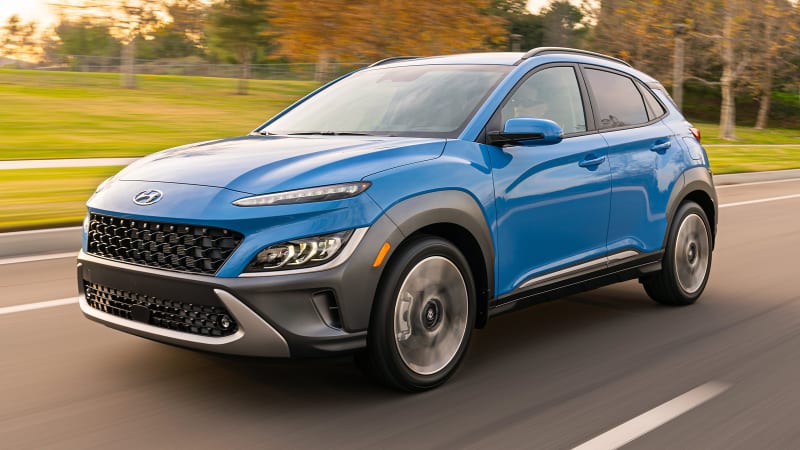
Hyundai is giving its 2022 Kona lineup a substantial refresh this year. It covers both the standard Kona and the Kona Electric. Both versions of the car get big exterior visual updates, and both receive similar interior upgrades, too
A giant, new split grille dominates the front face. The funky body cladding that strangely extended from the wheel arches into the headlight assembly is nixed, and in its place is a new front bumper that gives the appearance of wraparound cladding. Hyundai is calling the wide silver piece in the center a “skid plate element,” but there’s no actual skid plate. A similar wraparound cladding design is used on the rear bumper. Just like it did in front, the rear wheel arch cladding no longer extends into the light assembly, and is instead molded neatly around it. A new taillight design gives it a fresh lighting look, too. Hyundai says the Kona is 1.6 inches longer with the new bumpers.
The design is much more cohesive and less quirky than the outgoing Kona, though that’s not to say it isn’t still a bit odd. The biggest change is the introduction of a new N Line trim that you see pictured here:
It’s showing off the Kona’s new face, but in a much sportier manner. The most obvious visual change is the all-out deletion of the Kona’s gigantic body cladding. You can see that the pieces are still there, but they’ve been fully painted in body color paint. This visually lowers the Kona, making it look much more like a hatchback than a crossover. All the rugged cladding that was on the front bumper previously is replaced with body-color paint or mesh venting — however, some of the “venting” is clearly fake. It gets a front spoiler lip, a triple nostril just above the grille (reminds us of Audi Sport models), a diffuser-esque look to the rear bumper and a subtle twin exhaust. N Line badges find their places on the front bumper and front fenders. Plus, the N Line gets its own 18-inch wheel design.
The N Line’s interior package is less comprehensive, but it’s still enough to differentiate it from the normal model. You get unique black seats with red stitching and N Line logos on them, a black headliner, metal pedals, plus an N Line-specific steering wheel and shifter design.
Unfortunately, the N Line is a largely visual package, with no suspension tweaks to speak of. The same 1.6-liter turbocharged four-cylinder engine that comes in the Limited trim also ships with this model. That’s not to say it isn’t potent or fun, though, as output is 195 horsepower and 195 pound-feet of torque. This gets sent through a re-tuned (for 2022) seven-speed dual-clutch transmission. The standard non-N Line engine is still the 2.0-liter four-cylinder that pumps out 147 horsepower and 132 pound-feet of torque. It’s exclusively connected to a CVT.
Hyundai says it’s tweaked the suspension and chassis of all Konas for 2022 with the aim of providing more “linear stability and ride comfort.” It also gains new acoustic windshield glass, instrument panel insulation and more cargo area insulation for reduced NVH intrusion.
The interior as a whole received a light refresh with more tech, with the biggest update being an available 10.25-inch digital instrument cluster. Hyundai upgraded the base infotainment system from a 7-inch to an 8-inch screen, and is also introducing a 10.25-inch upgrade. Wireless Apple CarPlay and wireless Android Auto are newly available, and Hyundai’s Digital Key tech is making its way to the Kona. The updated interior also features a new and optional electronic parking brake along with ambient lighting. Hyundai says that cargo space and rear legroom is improved, but it doesn’t say by how much. Rear seat passengers will enjoy the convenience of USB port access this year, too.
As for other tech, Hyundai is stepping it up with the available driver assistance features. The blind-spot warning system is enhanced with collision avoidance capability. Hyundai’s excellent Highway Drive Assist lane-centering system can be optioned. Lastly, a rear cross traffic assist update will automatically brake the car should it detect an impending collision while backing up.
Kona Electric
Nothing on the electric hardware side is changing for the Electric — 258-mile range, single-motor, 201 horsepower and 291 pound-feet of torque — but it is getting a big exterior redesign to match the gas-powered Kona. The dimpled grille is gone, and in its place is a big empty space. It’s much simpler than before, and while it may be less distinct, it reduces its chances of being offensive to anyone. It also gets new wheels, new lights all around, and similar to the N Line, drops the black plastic cladding for body-color arches.
The interior update is along the same lines as the standard Kona, as it adds the new digital instrument cluster and infotainment options. The lower center console area adds wireless charging capabilities, too.
Hyundai says that both the gas and Electric variants will arrive to U.S. dealerships in spring this year. Pricing is not yet available on the updated models.
Related video:
